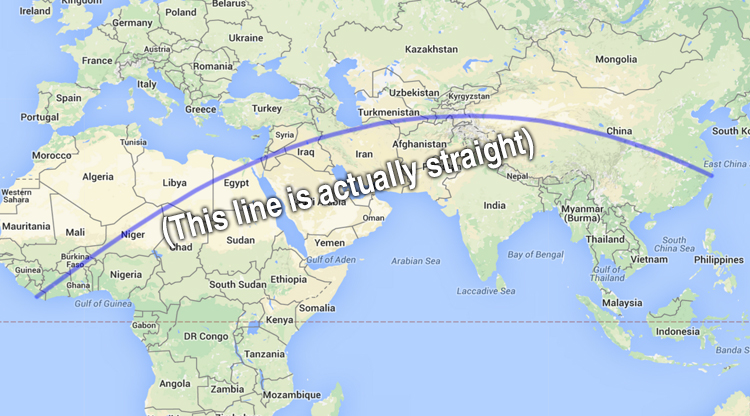These are momentous times for fashion in China. The local industry – which is hardly two decades old – has done nothing but grow since a first wave of homegrown designers debuted their work in the mid-90s. The business’ upper echelons around the world have since taken the country – and the wallets of its moneyed consumers - to heart. By now, it’s almost cliché to comment on how important China has become to the global luxury sector. Yet brands from Europe and the US keep opening stores across the PRC at unprecedented clip and, to promote brand awareness, restaging their runway shows for audiences with epic spectacles in Beijing and Shanghai.
Now, the country is getting the art show treatment. At the beginning of May, the Costume Institute of the Metropolitan Museum of Art in New York unveiled China: Through the Looking Glass, an exhibition paying homage to the influence of Chinese culture on Western fashion at a time before the rise of Mao Zedong, when Westerners saw the country as essentially mysterious and exotic.

A mix of music, film clips, photography and clothes, the show not only fills the Costume Institute but all of the museum’s Chinese art galleries too. Thomas Campbell, the museum’s director, said this might be the biggest show in its history. One explanation for its size is that it coincides with the centennial of the founding of the museum’s Asian art collection. Another is that China has reached the very top of the fashion game.
And, almost overnight, all (fashion) eyes are turning to the country.
“The novelty of Chinese designers is shifting,” says Alice McInerney, a fashion journalist and consultant based in Beijing. “You can now shop for Chinese fashion all over the world, in some of the most prestigious boutiques. Back in China, customers, while still attracted to international labels, are craving the unique and are much more open to opting for Chinese designers.”
And so are international media. From the New York Times to the Economist, SCMP and the Independent, a slew of major publications have started profiling Chinese designers and the state of the sector in the PRC.
.jpg)
During Shanghai Fashion Week last April, an International Shanghai Fashion Week Summit organized with the support of marketing and communication giant Ogilvy was held in the grand settings of the Mandarin Oriental, gathering media, buyers and international fashion figures of the caliber of British fashion commentator Colin McDowell and Business of Fashion founder Imran Amed. Panels were held to address original design in China, while pushing for a global agenda.
It’s like the Chinese fashion industry suddenly stopped being the lonely kid everyone makes fun of and turned into a grownup people are beginning to take seriously.
“China is finally getting the attention of the global arena. There used to be a distinction between East and West, but now we are all on a common platform,” says Tasha Liu, owner of concept store Dong Liang Studio – a boutique fostering exclusively Chinese designers in both Beijing and Shanghai - who took part in the forum. “Local talents have been growing steadily for quite some time now – they have refined their design and technical skills. It’s time they get the recognition they deserve.”

Met Gala Costume Exhibit: China Through The Looking Glass
That recognition is not only coming via an unprecedented attention to local independent fashion, but also by way of a new book, Fashion China, which was released in April to coincide with Shanghai Fashion Week and the summit.
Written by Irish-born fashion curator Gemma Williams (and available at Page One stores as well as on Amazon) Fashion China attempts to document the country's vibrant, albeit fledgling, fashion design industry. An anthology of 41 designers who are toiling hard to establish the reputation of “Designed in China,” it includes both established and more up-and-coming talents, revealing a diversity of tastes and aesthetics ranging from cutting edge to opulence to avant-garde and minimalism.
“‘Made in China’ has become so stereotyped,” Williams stated recently. "I want to highlight another view."
And let’s not forget the Met. The opening gala for the show – an extremely fashionable affair, as it is held and put together annually by queen of fashion and American Vogue’s chief editor Anna Wintour – saw mega stars and celebrities embracing the Chinese theme of the exhibition with gowns that tried to reference the country (sometimes with arguable results).

Photo: style.com
Rihanna went as far as to wear a creation by Guo Pei, China’s first couturiere, while omnipresent Chinese actress-turned-American import Fan Bingbing donned a gown by rising designer Christopher Bu. Dalian-born designer Huishan Zhang, on his part, was asked to do a Met-Ball themed collaboration with American retailer Barneys New York. “The fact that mega-celebs are wearing Chinese designers has turned Chinese fashion into a talking point,” says McInerney.
But is the buzz going to last, or is this only one of fashion’s fleeting flings?
“It’s difficult to say. China has no doubt left a mark on the industry’s radar, but independent designers have plenty of challenges to face, and not just here,” says Liu. “Maintaining the level that’s expected of them now is what’s going to determine their success – and critical acclaim - in the future. But I stay optimistic.”
During a visit to Beijing in January, (made to hype the Met show but also lure Chinese investors) Wintour shared equally positive feelings: “I’m sure within the next generation, we’ll see the emergence of Chinese designers on a global scale,” she told the Wall Street Journal.

Those designers, however, might not come directly from China.
Although first-tier cities like Beijing and Shanghai are striving to step up their game with state establishments like BIFT (Beijing Institute of Fashion Technology) or privately owned schools such as Istituto Marangoni or the recently opened Condé Nast Center of Fashion & Design in Shanghai, many dressmaker wannabes often fall for the lure of an international education.
Over the last five to 10 years, an increasing number of Chinese students have gone abroad to study fashion. Walk through Central St. Martins in London, and you’ll see swarms of Chinese creatives-in-the-making working on projects, exchanging notes, attending classes. Figures confirm it: as of two years ago, over 50,000 Chinese went to the United States to study art and design-related courses – that’s one-tenth of the total number of Chinese students in the US. Also in 2013, 9,000 Chinese traveled to Britain for the same reason.
Talents are looking outward, not inward. And, given their sheer numbers in foreign universities and their growing participation in fashion weeks abroad, it is only normal that some will make an impact on the industry.

Anais Mak
Masha Ma, who launched her label in Shanghai in 2008, is a case in point. A graduate of Central St. Martins, she was selected and shown at London Fashion Week and subsequently purchased by a retail store in London. Currently, she shows at Paris Fashion Week, where she’s become a fixture of the fashion circuit. Although she divides her time between Shanghai and Paris, it is the latter she calls home. “China is growing fast,” she says, “but it still has a lot to learn.”
Like Ma, many of China’s pre-eminent fashion designers have formed abroad and now show at international fashion weeks: Huishan Zhang, Yifang Wang, Haizhen Wang, Uma Wang, just to name a few. Many have also won prizes, awards and competitions, or received help to showcase their collections from organizations such as the British Fashion Council and Fashion Scout, which champions young creative talent.
This year, out of 26 designers on the shortlist for the LVMH Prize, six were Chinese (though none were named among the award’s eight finalists).

Chinese design is emerging as a legitimate player worldwide, yet the road ahead looks like a bumpy one.
With a title reeking slightly of orientalism (though its reviews have been overall quite favorable) China: Through the Looking Glass risked being a cradle for mistranslations and simplified preaching, as it is a show of appropriation, rather than one celebrating another culture (its focus is on Western designers’ use of Chinese elements rather than on China’s fashion itself). It’s a thorny territory, no doubt, and one that, transported into the realm of everyday fashion, might risk hindering the development of independent Chinese designers.
As with most things, the West has long had a way of deciding what is and isn’t fitting of certain (read: its own) criteria, categorizations or typecasting. With Chinese fashion, the idea of defining what makes it intrinsically 'Chinese' can easily fall into generalizations, stereotypes and confusion.
During the same trip in which she praised Chinese designers as the next big thing, Wintour also stated, “nothing that could be called modern Chinese style has yet emerged.”
Such assessment might refer to many things – the lack of a specific Chinese sensibility to fashion perhaps, or of a ‘school of thought’ encompassing most Chinese designers. What it might also hint at though, and what some have lamented, is the fact that there aren’t many Chinese designers who have a specifically ‘Chinese aesthetic’ – assuming this means a taste for Chinese themes revisited.
Does ethnicity have to play such a big part in the upward journey of a country’s style?
From a recent interview with the SCMP, Ma thinks not. “While I'm glad to be one of the strong voices of Chinese design, my aesthetic extends beyond my Chinese identity,” she told the newspaper.
Known for collections that incorporate highly contrasted and conflicted elements as well as totally different cultures, Xiamen-based designer Shanguan Zhe, founder of label Sankuanz, agrees. “It’s hard for me to say that my designs have just a Chinese aesthetic or just an ‘international’ aesthetic.”
Attempting to pigeon-hole Chinese design might indeed not be the best way to help it gain confidence.
“Most young designers want to be recognized on the world stage for their designs through shape, form and technique, not because they use overt ‘Chinese’ elements such as dragon motifs or gold and red embellishments,” says McInerney. “Chinese talent is showing at international fashion weeks, but it also has a strong presence right here in China. That should help shifting opinions so that designers can be viewed on the international stage, as opposed to just being 'Chinese’ designers.”

“Designers like Sankuanz or Uma Wang are just so different from each other,” Liu points out. ”But their standards, their ambition, are on the same level. That’s what brings them together.”
“The main thing Chinese designers should worry about isn’t what makes their work ‘Chinese,’ but how to improve their production process,” she continues. “The problem is the lack of resources and supplies – China is the world’s manufacturing center yet, somehow, it’s incapable of dealing with small-scale orders. And that affects young talents. The local industry should offer more support to ensure quality and help them flourish. Then, things can go far.”
Given the right support, there is more than enough potential to build a solid fashion industry in China, both in terms of commercial viability and creative clout. Let’s just leave typecasting and nitpicking definitions aside.






















0 User Comments